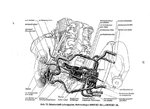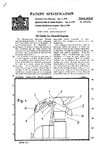Overall, I like the FW-190A series as a fighter, but one "feature" has me EXTREMELY puzzled. The oil cooler.
Now, im sure all of you know, most radial (or air cooled) aircraft engines had a separate oil cooler. Typically placed in the chin (A6M, P-47, LA-5) or in the wings (F4U, Sea Fury). The FW-190A series had an extremely complex and very heavy oil cooling system, and I simply cant find the logic behind it. First, let me catch up those who are not familure with the 801's oil cooler.

In the front of the engine, just aft of the ducted fan, is a ring around the inside of the cowling. Thats the oil cooler. Here I highlighted it in red.

Also note the fan just behind the prop (3). That also helps dump air into the oil cooler, along with keeping the cylinders cool. Also, the air from the fan, had to travel and S bend to get to the cooler. Any time you change the direction of air, you impart drag and friction/resistance. So the air had to turn 180 degrees twice.
Now, since the oil cooler was so massive, and in a very vulnerable place, they armored it with between 1/3 to 1/8th " armor plate (depending on the model, and my numbers are from memory, but im sure someone will correct me).
Now, my question is, was all this added weight really worth the slight aerodynamic benefit? First, you have the added weight of the cooler, then the added weight of the armor plating, and then the ducted fan. With a standard cowling like that on most radial engine fighters, Kurt Tank would of saved a massive amount of weight! Also, the cooling fan dragged a bit of HP from the engine since it spun 1/3 faster then the prop.
I simply cant understand the logic of such a heavy and complex system. My only guess is it has something to do with the FW-190V1. In the late 1930's, there was a massive push for streamlining, and radial engines on a fighter was deemed to be not adequate for fighters due to its large frontal area. Then the NACA cowling came along and changed things a little. In looking at the early FW-190V1 with the ducted spinner, Kurt Tank was trying to make an extremely streamlined radial fighter. In that, his complex oil cooler is streamlined. But, it didnt work out so well, due to heat. They had to remove the cowled spinner and adopt a more standard cowling, but for some reason, kept the oil cooler ring.
Now, what puzzles me is that if it truly was an innovation with notable gains, why was it not copied? Lets face it. In the late 30's it was a true golden age of aviation innovation. Every great discovery was adapted and copied to the next line of fighters. NACA cowling, flush rivits, constant speed props, you name it, it was copied and crammed into the next fighter. Everything but this oil cooler ring. The Japanese did copy the ducted fan on a few prototypes, and the J2M series, but stayed with a standard oil cooler. Also, many aircraft had the large spinner, but not the ducted fan, like the LA5 and Sea Fury. Even the prototype F4F had a large spinner.
So, with all the weight, drag on the engine, and such, was the FW-190A BMW801 oil cooler ring really worth it? Did its aerodynamic benefits outweigh the cost in weight and resistance?
Now, im sure all of you know, most radial (or air cooled) aircraft engines had a separate oil cooler. Typically placed in the chin (A6M, P-47, LA-5) or in the wings (F4U, Sea Fury). The FW-190A series had an extremely complex and very heavy oil cooling system, and I simply cant find the logic behind it. First, let me catch up those who are not familure with the 801's oil cooler.

In the front of the engine, just aft of the ducted fan, is a ring around the inside of the cowling. Thats the oil cooler. Here I highlighted it in red.
Also note the fan just behind the prop (3). That also helps dump air into the oil cooler, along with keeping the cylinders cool. Also, the air from the fan, had to travel and S bend to get to the cooler. Any time you change the direction of air, you impart drag and friction/resistance. So the air had to turn 180 degrees twice.
Now, since the oil cooler was so massive, and in a very vulnerable place, they armored it with between 1/3 to 1/8th " armor plate (depending on the model, and my numbers are from memory, but im sure someone will correct me).
Now, my question is, was all this added weight really worth the slight aerodynamic benefit? First, you have the added weight of the cooler, then the added weight of the armor plating, and then the ducted fan. With a standard cowling like that on most radial engine fighters, Kurt Tank would of saved a massive amount of weight! Also, the cooling fan dragged a bit of HP from the engine since it spun 1/3 faster then the prop.
I simply cant understand the logic of such a heavy and complex system. My only guess is it has something to do with the FW-190V1. In the late 1930's, there was a massive push for streamlining, and radial engines on a fighter was deemed to be not adequate for fighters due to its large frontal area. Then the NACA cowling came along and changed things a little. In looking at the early FW-190V1 with the ducted spinner, Kurt Tank was trying to make an extremely streamlined radial fighter. In that, his complex oil cooler is streamlined. But, it didnt work out so well, due to heat. They had to remove the cowled spinner and adopt a more standard cowling, but for some reason, kept the oil cooler ring.
Now, what puzzles me is that if it truly was an innovation with notable gains, why was it not copied? Lets face it. In the late 30's it was a true golden age of aviation innovation. Every great discovery was adapted and copied to the next line of fighters. NACA cowling, flush rivits, constant speed props, you name it, it was copied and crammed into the next fighter. Everything but this oil cooler ring. The Japanese did copy the ducted fan on a few prototypes, and the J2M series, but stayed with a standard oil cooler. Also, many aircraft had the large spinner, but not the ducted fan, like the LA5 and Sea Fury. Even the prototype F4F had a large spinner.
So, with all the weight, drag on the engine, and such, was the FW-190A BMW801 oil cooler ring really worth it? Did its aerodynamic benefits outweigh the cost in weight and resistance?



